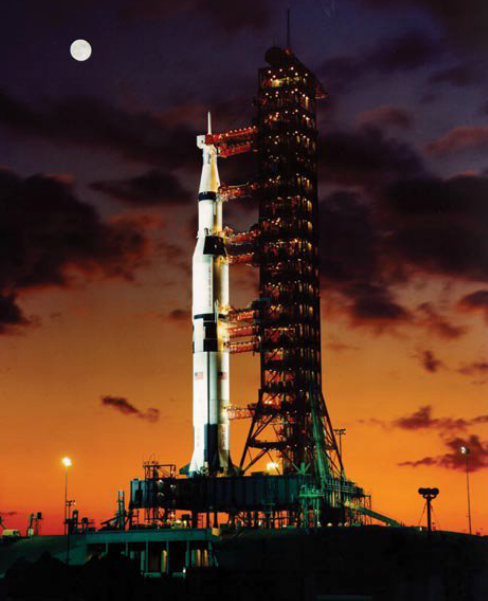I believe that America – this time with her international partners – should go back to the moon.
I am disappointed that we left thirty years ago. I am thrilled when I watch movies like “Apollo 13” and “The Dish.” I think that lunar exploration would be wonderful for national prestige and that it would teach us a great deal about the techniques needed to explore Mars. Any nation that has a research station at the Antarctic South Pole ought to have one on the moon. I want Americans to be on the Moon to greet the Chinese when they arrive.
Having said all of that, I have to state my belief that the National Aeronautics and Space Administration (NASA) is not ready to take us there.
One could easily reply that NASA was not ready to fly to the moon in 1961 when President John F. Kennedy made his famous commitment. We had yet to orbit John Glenn, build the Saturn V rocket, and master lunar orbit rendezvous.
Getting Armstrong and Aldrin to the moon and back cost $21.4 billion in the currency of its day. That is the equivalent, adjusting for inflation, of about $150 billion today.
Indeed, the organization that placed Neil Armstrong and Buzz Aldrin on the moon in 1969 was not the same NASA that received President Kennedy’s mandate in 1961. It was bigger, richer, smarter, and twice reorganized to engage the complexities of lunar flight. In similar ways, it needs to be revitalized again.
Today NASA’s budget is essentially fixed at about $17 billion per year, with adjustments for inflation. Much of that budget is committed to projects other than going to the moon. The fiscal constraints placed on the new lunar effort are as demanding – some would say more severe – than the time deadline imposed by President Kennedy in 1961.

Getting Armstrong and Aldrin to the moon and back cost $21.4 billion in the currency of its day. That is the equivalent, adjusting for inflation, of about $150 billion today. Since NASA will not need to reinvent every wheel and rebuild its field centers, the next voyage will not cost as much as the first. Some say that NASA could return for as little as 50 percent of the initial expedition. Yet finding $75 billion or more in an agency on a fixed budget will be a substantial challenge.
NASA could do it for less. The six missions that followed Apollo 11 each cost the equivalent of about $4 billion in today’s dollars. Once NASA and its contractors learned how to put the first humans on the Moon, subsequent missions were cheaper. It also helped that a lot of hardware acquired for Apollo 11 was left over when the astronauts returned home.
Still, even at $4 billion per landing, NASA could not expect to make more than one or two visits per year with all of its other current commitments. Additionally, this assumes that NASA uses Apollo-style technology or what some have called “Apollo on steroids.” Apollo technology, however, will never get us to Mars. Cost estimates for a mission to Mars using Apollo-style propulsion and spacecraft methods range from $500 billion to $1 trillion.
The whole Space Exploration Vision – which includes new rockets, new spacecraft, lunar voyages, and preparations for Mars – is premised on the myth of what is referred to as the “wedge.” It presumes that NASA can conjure up new funds by closing old programs. The space shuttle, at $5 billion per year, and the international space station are certainly tempting targets for this philosophy.
Yet we have heard this story before. In the early 1980s, after NASA executives convinced President Ronald Reagan to declare the space shuttle “fully operational,” they argued that an international space station could be financed with funds freed up by ending the shuttle development effort. Then-NASA Administrator Dan Goldin tried to pay for the X-33 – one of many efforts to replace the space shuttle – by freezing shuttle upgrades and reducing the shuttle workforce. It didn’t work then and it is unlikely to work now.
NASA needs to invest in new rocket technologies, like nuclear propulsion. It needs to invest in new types of spacecraft. It needs to invest in missions such as the effort to locate earth-like planets around neighboring stars, which holds enormous promise as a means of exciting long-term interest in space exploration. NASA needs to hire the next great generation of space flight engineers and revitalize its in-house technical capability. It needs to learn how to conduct low-cost space flight missions for humans, as it has already done in the robotics field, and as entrepreneurs like Burt Rutan are trying to do now.
These are painstaking necessities, ones likely to delay an Apollo-style return to the Moon. I am sorry that this is the case, because, as indicated, I want to go back to the Moon, too. But there are many things I want and only a few that I can have. On reflection, I think it would be better to have a sustained space exploration effort supported by new, low-cost technologies and a smart NASA rather than a focused effort to return to the Moon.
Howard E. McCurdy is professor of public affairs at American University, and the author of six books on the U.S. space program, including Space and the American Imagination and Faster Better Cheaper: Low Cost Innovation in the U.S. Space Program.




